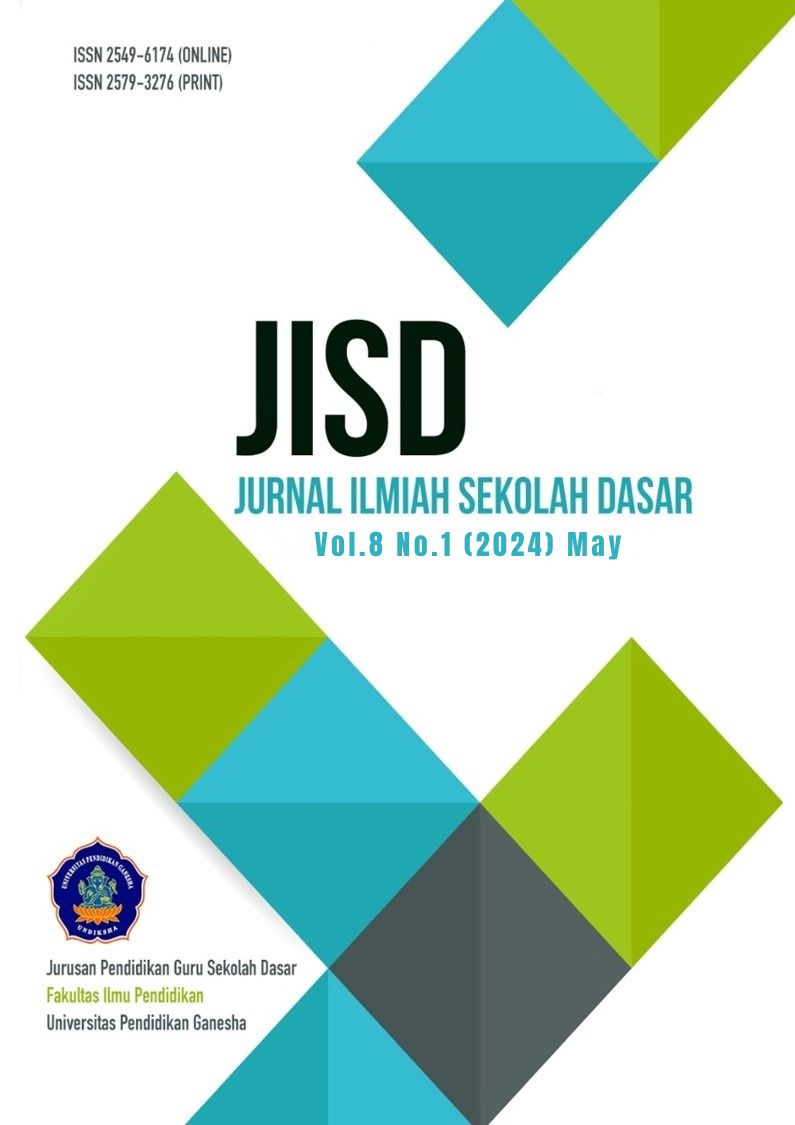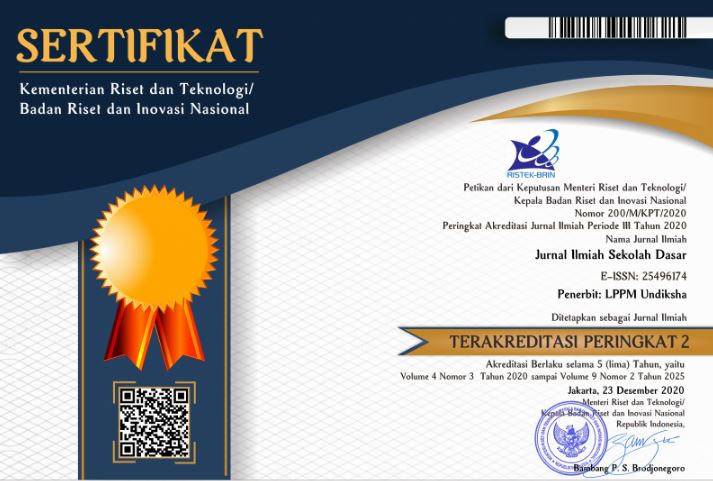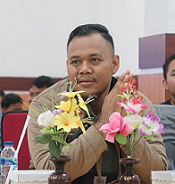Word Bank: Learning Media on Poetry Writing Materials for Fourth Grade of Elementary School
DOI:
https://doi.org/10.23887/jisd.v8i2.67640Keywords:
learning media, Writing Poetry, elementary schoolsAbstract
Students benefit from writing poetry because they can express their feelings at the time through beautiful words in the form of poetry. Writing poetry in learning can be packaged using learning media. Learning media is extremely beneficial to the learning process. Students will understand the material provided by the teacher more easily if they use learning media. Therefore, this research aims to produce the learning media product "Word Bank" to improve the ability to write poetry in fourth grade elementary school. This study applied the Hannafin and Peck model of Research and Development. In this study, 15 students of IV grade were used as research subjects. Observation, interviews, questionnaires, and documentation were used as research instruments. Interactive analysis techniques and presentations were used in data analysis techniques. According to the research findings, “Word Bank” learning media has a “very high” feasibility level. The results of the initial trial, which was conducted on 5 students, were classified as “very high” based on the acquisition of the two scores obtained. Students’ pretest and post-test scores in the experimental class showed a t-count of -8.817 with df 18 and Sig. (2-tailed) of 0.000. Thus, the results of the t-test for the pretest and post-test values of the experimental class show that the value of Sig. (2-tailed) 0.000 < 0.05 (5%). Can be concluded that there is a significant difference in ability wrote poetry.
References
Ahsin, M. N. (2016). Peningkatan Keterampilan Menulis Karangan Narasi Dengan Menggunakan Media Audiovisual Dan Metode Quantum Learning. Jurnal Ilmiah Pendidikan, 6(2), 158–171. https://doi.org/10.24176/re.v6i2.607. DOI: https://doi.org/10.24176/re.v6i2.607
Al-Ahdal, A. A. M. H., & Abduh, M. Y. M. (2021). English Writing Proficiency and Apprehensions Among Saudi College Students: Facts and remedies. TESOL International Journal, 16(1), 34–56. https://www.researchgate.net/profile/Mariam-Abduh/publication/348327244.
Ambarwati, W. (2018). Pengembangan Model Sinektik Berbantuan Media Video dalam Pembelajaran Menulis Puisi pada Peserta Didik di Kelas V SD. Tarling : Journal of Language Education, 1(1). https://doi.org/10.24090/tarling.v1i1.1125. DOI: https://doi.org/10.24090/tarling.v1i1.1125
Azizah, A. (2015). Pembelajaran Menulis Puisi Dengan Memanfaatkan Teknik Brainwriting Pada Peserta Didik SD/MI Kelas V. Jurnal Pendas, 2(2). https://doi.org/10.30659/pendas.2.2.136-140. DOI: https://doi.org/10.30659/pendas.2.2.136-140
B.Milles, M., Hubberman, A. M., & S, J. (2014). Qualitative Data Analysis: A Methods Sourcebook. In SAGE Publications, Inc.
Bachry, H., Yuwono, J., & Utami, Y. T. (2018). Penggunaan Media Word Wall Untuk Meningkatkan Kemampuan Menulis Tegak Bersambung (Studi Single Subject Research Pada Siswa Tunarungu Kelas III Di SKh Negeri 02 Kota Serang Banten ). JUrnal UNIK, 3(1), 1–9. https://doi.org/10.30870/unik.v3i1.5301.
Boangmanalu, D., Jampel, I. N., & Suwatra, I. I. W. (2018). Pengembangan Media Komik Dengan Model Hannafin Dan Peck Pada Mata Pelajaran Ips Kelas V Sd Negeri 4 Kampung Baru Tahun 2017/2018. Jurnal Edutech Undiksha, 6(2). https://doi.org/10.23887/jeu.v6i2.20288.
Bupu, S., Rukayah, R., & Subiyantoro, S. (2018). Influence of Writing Poetry Module Using in Contextual Learning to Writing Poetry Learning Result of Elementary Student. International Journal of Multicultural and Multireligious Understanding, 5(2). https://doi.org/10.18415/ijmmu.v5i2.229. DOI: https://doi.org/10.18415/ijmmu.v5i2.229
Certo, J. (2017). Poems That Move: Children Writing Poetry beyond Popularized Poetic Forms. Language Arts, 94(6). https://doi.org/10.58680/la201729165. DOI: https://doi.org/10.58680/la201729165
Chan, S., & Yamashita, J. (2022). Integrated writing and its correlates: A meta-analysis. Assessing Writing, 54. https://doi.org/10.1016/j.asw.2022.100662. DOI: https://doi.org/10.1016/j.asw.2022.100662
Daryanes, F., Darmadi, D., Fikri, K., Sayuti, I., Rusandi, M. A., & Situmorang, D. D. B. (2023). The Development of Articulate Storyline Interactive Learning Media Based on Case Methods to Train Students Problem-Solving Ability. Heliyon, 9(4). https://doi.org/10.1016/j.heliyon.2023.e15082. DOI: https://doi.org/10.1016/j.heliyon.2023.e15082
Deveney, C. (2021). Psychology and creative writing: the role of experiential learning in the journey from fact to fiction, and the implications for therapy. Journal of Poetry Therapy, 34(1), 24–36. https://doi.org/10.1080/08893675.2020.1846864. DOI: https://doi.org/10.1080/08893675.2020.1846864
Febriana, A., Sutansi, S., & Mudiono, A. (2018). Peningkatan Keterampilan Menulis Puisi Melalui Model Contextual Teaching And Learning (CTL). Wahana Sekolah Dasar. https://doi.org/10.17977/um035v26i22018p036. DOI: https://doi.org/10.17977/um035v26i22018p036
Hariyanti, W., Astra, I. ketut B., & Suwiwa, I. G. (2019). Pengembangan Model Latihan Fleksibilitas Tingkat Pemula dalam Pembelajaran Pencak Silat. Jurnal Penjakora, 6(1), 57. https://doi.org/10.23887/penjakora.v6i1.17713. DOI: https://doi.org/10.23887/penjakora.v6i1.17713
Haryana, M. R. A., Warsono, S., Achjari, D., & Nahartyo, E. (2022). Virtual reality learning media with innovative learning materials to enhance individual learning outcomes based on cognitive load theory. International Journal of Management Education, 20(3). https://doi.org/10.1016/j.ijme.2022.100657. DOI: https://doi.org/10.1016/j.ijme.2022.100657
Herawati Daulae, T. (2019). Langkah-Langkah Pengembangan Media Pembelajaran Menuju Peningkatan Kualitas Pembelajaran. Forum Paedagogik, 11(1). https://doi.org/10.24952/paedagogik.v11i1.1778. DOI: https://doi.org/10.24952/paedagogik.v11i1.1778
Iida, A., & Chamcharatsri, B. (2022). Emotions in second language poetry writing: a poetic inquiry into Japanese EFL students’ language learning experiences. Innovation in Language Learning and Teaching, 16(1). https://doi.org/10.1080/17501229.2020.1856114. DOI: https://doi.org/10.1080/17501229.2020.1856114
Indihadi, D. (2018). Pembelajaran Menulis Berbasis “Brainstorming.” Indonesian Journal of Primary Education, 2(2). https://doi.org/10.17509/ijpe.v2i2.15172. DOI: https://doi.org/10.17509/ijpe.v2i2.15172
Isyani, Nf. (2017). Media Gambar Yang Diproyeksikan Untuk Meningkatkan Keterampilan Menulis Puisi Pada Siswa Kelas 3 SD Banyuripan. Jurnal Teknodik, 20(2). https://doi.org/10.32550/teknodik.v20i2.244. DOI: https://doi.org/10.32550/teknodik.v20i2.244
Kristiantari, M. G. R., Widiana, I. W., & Artawan, G. (2023). Enhancing the ability to write poetry and creative thinking skills with rural nature-inspired contextual approach. International Journal of Evaluation and Research in Education (IJERE), 12(2), 761–770. https://ijereiaescore.org/article/view/23194.html. DOI: https://doi.org/10.11591/ijere.v12i2.23194
Kunto, I., Ariani, D., Widyaningrum, R., & Syahyani, R. (2021). Ragam Storyboard Untuk Produksi Media Pembelajaran. Jurnal Pembelajaran Inovatif, 4(1), 108–120. https://doi.org/10.21009/jpi.041.14. DOI: https://doi.org/10.21009/JPI.041.14
Maciejewski, M. L. (2020). Quasi-experimental design. Biostatistics and Epidemiology, 4(1). https://doi.org/10.1080/24709360.2018.1477468. DOI: https://doi.org/10.1080/24709360.2018.1477468
Maimunah, M. (2016). Metode Penggunaan Media Pembelajaran. Al-Afkar : Jurnal Keislaman & Peradaban. https://doi.org/10.28944/afkar.v5i1.107. DOI: https://doi.org/10.28944/afkar.v5i1.107
Mardalela, B., Yuliantini, N., & Anggraini, D. (2019). Pengaruh Media Video Terhadap Kemampuan Menulis Puisi Kelas V Sekolah Dasar Se- Kota Bengkulu. Jurnal Riset Pendidikan Dasar, 2. https://doi.org/10.33369/juridikdas.2.2.120%20-%20125. DOI: https://doi.org/10.26618/jrpd.v2i1.1586
Marlani, L., & Prawiyogi, A. G. (2019). Penerapan Model Pembelajaran Project Based Learning Untuk Meningkatkan Keterampilan Menulis Puisi Di Sekolah Dasar. Al-Aulad: Journal of Islamic Primary Education, 2(1). https://doi.org/10.15575/al-aulad.v2i1.4427. DOI: https://doi.org/10.15575/al-aulad.v2i1.4427
Mustika, I., & Lestari, R. D. (2016). Hubunganminat baca dan kebiasaan membaca karya sastra terhadap kemampuan menulis puisi. Jurnal Semantik STKIP Siliwangi, 5(2). https://doi.org/10.22460/semantik.v5i2.p%25p.
Nurdyansyah. (2019). Media Pembelajaran Inovatif. Umsida Press. DOI: https://doi.org/10.21070/2019/978-602-5914-71-3
Nurrita, T. (2018). Pengembangan Media Pembelajaran Untuk Meningkatkan Hasil Belajar Siswa. Jurnal Ilmu-Ilmu Al-Quran, Hadist, Syari’ah Dan Tarbiyah, 3(1), 171. https://lmsspada.kemdikbud.go.id/pluginfile.php/423559/mod_resource/content/2/Bahan bacaan.pdf. DOI: https://doi.org/10.33511/misykat.v3n1.171
Pujiastuti, A. U. (2020). Analisis Penerapan Metode Index Card Match Dalam Pembiasaan Literasi Bahasa Produktif Siswa Sekolah Dasar. Refleksi Edukatika : Jurnal Ilmiah Kependidikan, 11(1). https://doi.org/10.24176/re.v11i1.4879. DOI: https://doi.org/10.24176/re.v11i1.4879
Pujiastuti, A. U., Mizan, S., & Agustin, I. (2018). Analisis Kemampuan Bahasa Produktif dan Reseptif pada Siswa Tuna Rungu di SDN Inklusi Kecamatan Montong Kabupaten Tuban. Prosiding Seminar Nasional Hasil Penelitian Dan Pengabdian Kepada Masyarakat III, 3(1). http://journal.unj.ac.id/unj/index.php/jpk/article/view/5743.
Puspitarini, Y. D., & Hanif, M. (2019). Using learning media to increase learning motivation in elementary school. Anatolian Journal of Education, 4(2), 53–60. https://doi.org/10.29333/aje.2019.426a. DOI: https://doi.org/10.29333/aje.2019.426a
Rinawati, A., Mirnawati, L. B., & Setiawan, F. (2020). Analisis Hubungan Keterampilan Membaca dengan Keterampilan Menulis Siswa Sekolah Dasar. Education Journal : Journal Educational Research and Development. https://doi.org/10.31537/ej.v4i2.343. DOI: https://doi.org/10.31537/ej.v4i2.343
Saputro, T. A., Kriswandani, & Ratu, N. (2018). Pengembangan Media Pembelajaran Mengunakan Aplikasi Construct 2 Pada Materi Aljabar Kelas VII. Jurnal Teori Dan Aplikasi Matematika, 2(1), 1–8. https://doi.org/10.29100/jp2m.v4i1.1775. DOI: https://doi.org/10.31764/jtam.v2i1.219
Sari, A. W. (2016). Kontribusi Minat Baca Puisi Dan Penguasaan Gaya Bahasa Terhadap Keterampilan Menulis Puisi Bebas Siswa Kelas IX Smp Negeri 2 Lembah Gumanti. Gramatika STKIP PGRI Sumatera Barat, 2(2). https://doi.org/10.22202/jg.2016.v2i2.1087. DOI: https://doi.org/10.22202/jg.2016.v2i2.1087
Sigit, V. S., Devi, A. Y., & Rieta, P. (2020). Pengaruh Media Big Book Terhadap Keterampilan Menulis Puisi Siswa Sekolah Dasar. Jurnal Tunas Bangsa. https://doi.org/10.46244/tunasbangsa.v7i1.978. DOI: https://doi.org/10.46244/tunasbangsa.v7i1.978
Sulthony, M., Saputro, A. W., Sanni, Z., Alfariz, A., & Suryaningrum, H. (2016). Pengembangan Media Pembelajaran Pengenalan Pangan Lokal Untuk Siswa Kelas IV Sekolah Dasar. Yogyakarta Jurnal, 11, 54–65. https://www.academia.edu/download/106611563/8869-22112-1-SM.pdf.
Susanti, A., Mustadi, A., Asnimar, A., & Susiloningsih, E. (2019). The Improvement in Poetry Writing Skills by Using Prezi in the Primary School. Mimbar Sekolah Dasar, 6(1). https://doi.org/10.17509/mimbar-sd.v6i1.14557. DOI: https://doi.org/10.17509/mimbar-sd.v6i1.14557
Tafonao, T. (2018). Peranan Media Pembelajaran Dalam Meningkatkan Minat Belajar Mahasiswa. Jurnal Komunikasi Pendidikan, 2(2), 103. https://doi.org/10.32585/jkp.v2i2.113. DOI: https://doi.org/10.32585/jkp.v2i2.113
Tsalitsatul Maulidah. (2020). Peningkatan Keterampilan Menulis Puisi Dengan Media Gambar. Karangan: Jurnal Bidang Kependidikan, Pembelajaran, Dan Pengembangan, 2(01), 64–70. https://doi.org/10.55273/karangan.v2i01.46. DOI: https://doi.org/10.55273/karangan.v2i01.46
Utami, A. F., Djuanda, D., & Aeni, A. N. (2016). Penerapan Permainan Bank Kata dalam Upaya Meningkatkan Keterampilan Menulis Puisi Bebas. Jurnal Pena Ilmiah, 1(1), 201–210. https://doi.org/10.17509/jpi.v1i1.2954.
Van, N. T., A., A. F., A., H., Fareed, A., & Daniel, D. (2021). “Digital Readiness for Social Educators in Health Care and Online Learning During the COVID-19 Pandemic: A Bibliometric Analysis.” International Journal of Interactive Mobile Technologies, 15(18), 104–15,. https://doi.org/10.3991/ijim.v15i18.25529. DOI: https://doi.org/10.3991/ijim.v15i18.25529
Wang, H., Orosco, M. J., Peng, A., Long, H., Reed, D. K., & Lee Swanson, H. (2023). The relation of bilingual cognitive skills to the second language writing performance of primary grade students. Journal of Experimental Child Psychology, 238. https://doi.org/10.1016/j.jecp.2023.105776. DOI: https://doi.org/10.1016/j.jecp.2023.105776
Waraulia, A. M. (2017). BANK KATA: Ide Media Pembelajaran Bahasa dan Sastra Indonesia. Jurnal Pembelajaran Ilmiah, 1(2). https://doi.org/10.25273/widyabastra.v1i2.1151.
Widyawati, Y. (2018). Teknik Teks Modelling: Meningkatan Hasil Belajar Menulis Puisi Pada Bidang Studi Bahasa Indonesia. Jurnal Pendidikan : Riset Dan Konseptual, 2(2). https://doi.org/10.28926/riset_konseptual.v2i2.37. DOI: https://doi.org/10.28926/riset_konseptual.v2i2.37
Wijayanti, W., Maharta, N., & Suana, W. (2017). Pengembangan Perangkat Blended Learning Berbasis Learning Management System pada Materi Listrik Dinamis. Jurnal Ilmiah Pendidikan Fisika Al-Biruni, 6(1). https://doi.org/10.24042/jpifalbiruni.v6i1.581. DOI: https://doi.org/10.24042/jpifalbiruni.v6i1.581
Yarmi, G. (2017). Pembelajaran Menulis Di Sekolah Dasar. Perspektif Ilmu Pendidikan, 31(1). https://doi.org/10.21009/pip.311.1. DOI: https://doi.org/10.21009/PIP.311.1
Downloads
Published
How to Cite
Issue
Section
License
Copyright (c) 2024 Alfianita Ayu Larasati, Ali Mustadi

This work is licensed under a Creative Commons Attribution-ShareAlike 4.0 International License.
Authors who publish with the Journal Ilmiah Sekolah Dasar agree to the following terms:
- Authors retain copyright and grant the journal the right of first publication with the work simultaneously licensed under a Creative Commons Attribution License (CC BY-SA 4.0) that allows others to share the work with an acknowledgment of the work's authorship and initial publication in this journal.
- Authors are able to enter into separate, additional contractual arrangements for the non-exclusive distribution of the journal's published version of the work (e.g., post it to an institutional repository or publish it in a book), with an acknowledgment of its initial publication in this journal.
- Authors are permitted and encouraged to post their work online (e.g., in institutional repositories or on their website) prior to and during the submission process, as it can lead to productive exchanges, as well as earlier and greater citation of published work. (See The Effect of Open Access)










